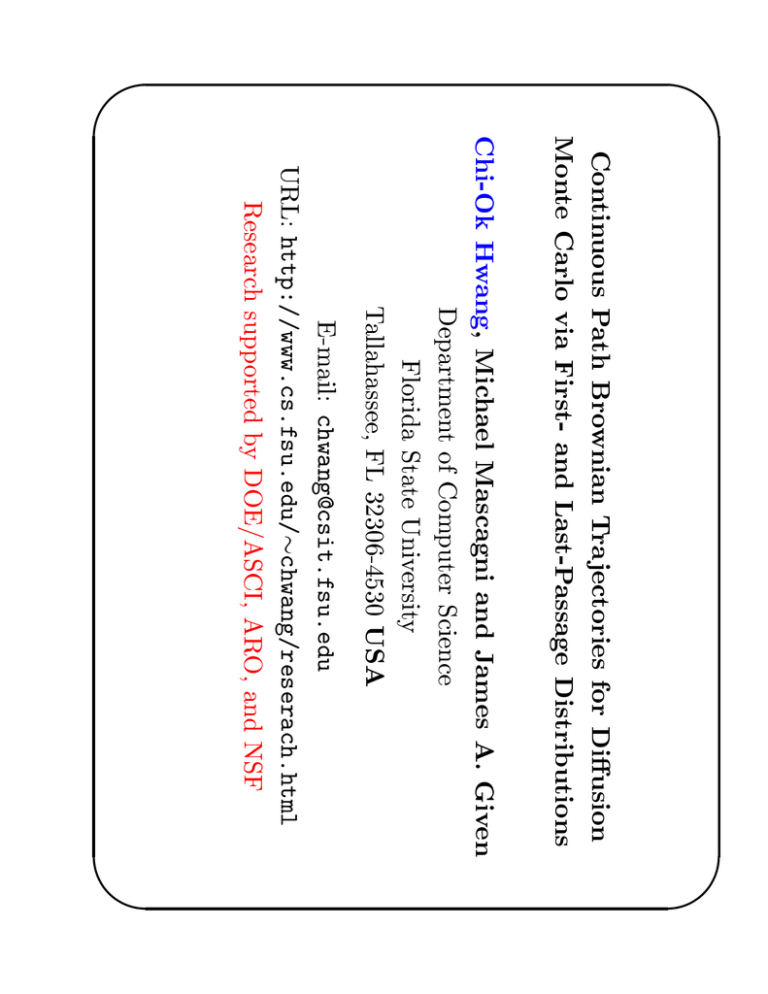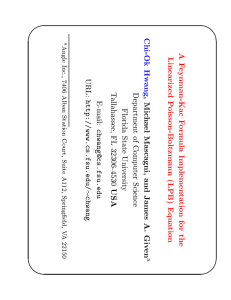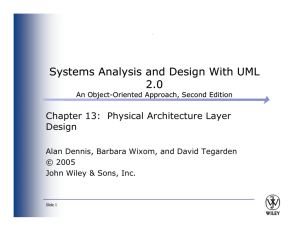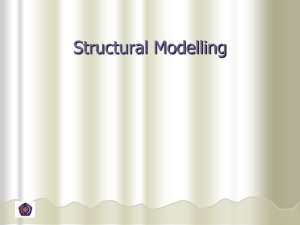' & Mon Con
advertisement

'
Continuous Path Brownian Trajectories for Diusion
Monte Carlo via First- and Last-Passage Distributions
Chi-Ok Hwang, Michael Mascagni and James A. Given
Department of Computer Science
Florida State University
Tallahassee, FL 32306-4530 USA
E-mail: chwang@csit.fsu.edu
URL: http://www.cs.fsu.edu/chwang/reserach.html
Research supported by DOE/ASCI, ARO, and NSF
&
$
%
'
Table of Contents
linearized Poisson-Boltzmann Equation
First Passage (FP) Algorithms
\Walk on Spheres" (WOS) Algorithm
Green's Function First Passage (GFFP) Algorithm
{ Angle-averaging Method
Fluid Permeability
{ Simulation-Tabulation GF Method
Solc-Stockmayer Model
Mean Trapping Rate
Eective Conductivity
Feymann-Kac Formula
{
&
Dr. Chi-Ok Hwang
Slide
1
$
%
'
Table of Contents
Last Passage Algorithms
Approach from Outside
Charge Density on a Circular Disk
Future Work
&
Dr. Chi-Ok Hwang
Slide
2
$
%
'
$
Dirichlet problem for Laplace Equation
@
( )
X @ first−passage location
x; starting point
Ω
&
Dr. Chi-Ok Hwang
Slide
3
%
'
First Passage Algorithms
Z
s
y
y
Z
Slide
u(x) = q(x); x 2 (1)
u(x) = f (x);
x 2 @ :
(2)
@G(x; y )
u(x) =
f (y )dS +
G(x; y )q (y )dy
(3)
@n
Isomorphism: First passage probability is exactly the Laplacian
surface Green's function for the boundary value problem for
the given geometry.
Electrostatic charge density on a conducting rst-passage
surface induced by a charge to rst-passage probability density
on the absorbing rst-passage surface surrounding the diusing
particle.
&
Dr. Chi-Ok Hwang
4
$
%
'
$
\Walk on Spheres" (WOS) and Green's
Function First Passage (GFFP)
Algorithms
WOS:
O
&
Dr. Chi-Ok Hwang
Shell thickness
ε
Slide
5
%
'
$
Timing with WOS:
3500
running time (secs)
3000
&
Dr. Chi-Ok Hwang
2500
2000
1500
1000
500 −8
10
logarithmic regression
10
−7
10
−6
10
−5
−4
10
ε
10
−3
10
−2
10
−1
10
0
Slide
6
%
'
$
Green's Functions
O
O
&
(a) Putting back
Dr. Chi-Ok Hwang
(b) Void space
O
(c) Intersecting
Slide
7
%
'
$
GFFP:
δ
O
&
Dr. Chi-Ok Hwang
Slide
8
%
'
$
2000
1975
running time (secs)
1950
1925
1900
1875
1850
1825
ε = 0.0000
ε = 0.0003
ε = 0.0005
1800
&
Dr. Chi-Ok Hwang
1775
1750
0
0.05
0.1
0.15
0.2
0.25
δ
Slide
9
%
'
$
Darcy's Law
∆P : pressure difference
Fluid
flux
q
11111111111
00000000000
00000000000
11111111111
00000000000
11111111111
00000000000
11111111111
00000000000
11111111111
Porous medium
00000000000
11111111111
00000000000
11111111111
00000000000
11111111111
00000000000
11111111111
00000000000
11111111111
00000000000
11111111111
00000000000
11111111111
00000000000
11111111111
00000000000
11111111111
00000000000
11111111111
00000000000
11111111111
00000000000
11111111111
00000000000
11111111111
00000000000
11111111111
00000000000
11111111111
00000000000
11111111111
00000000000
11111111111
00000000000
11111111111
00000000000
11111111111
00000000000
11111111111
00000000000
11111111111
00000000000
11111111111
00000000000
11111111111
00000000000
11111111111
00000000000
11111111111
00000000000
11111111111
Fluid
thickness
L
&
Dr. Chi-Ok Hwang
k ∆P
q = −−−−−−−
ηL
η : dynamic viscosity
Slide
10
%
'
P
= kL
Darcy's Law
q
A slow steady ow of a single Newtonian uid through a
stationary, inert and isotropic porous medium
q :
L :
P :
k :
uid permeability
applied pressure dierence
thickness of the porous sample
: dynamic viscosity
volumetric ow per unit cross-sectional area (ux)
&
Dr. Chi-Ok Hwang
(4)
Slide
11
$
%
'
Hubbard-Douglas TFC for an Arbitrary
Nonskew Object
f
= 6C
Slide
(5)
Using angle averaging, Hubbard and Douglas derived: vector or
tensor Laplace equations to scalar Laplace equations
f :
C :
translational friction coeÆcient
: dynamic viscosity
electrical capacitance
&
Dr. Chi-Ok Hwang
12
$
%
'
2
rP = r V
0
2
k
= 6RG ()f1 + 23
V;
( )g
G0 1
(6)
(7)
Slide
Felderhof's TFC for a Macromolecule
f
From the Debijf-Brinkman equation for porous ow under
pressure:
R :
translational friction coeÆcient
: dynamic viscosity
macromolecular radius
f :
we get:
{
{
{
&
Dr. Chi-Ok Hwang
13
$
%
'
G0
= pR
() = 1 1 tanh k
(8)
(9)
Slide
Felderhof's TFC for a Macromolecule
with:
uid permeability
dimensionless quantity:
k :
&
Dr. Chi-Ok Hwang
14
$
%
'
&
Dr. Chi-Ok Hwang
Porous Media
Slide
15
$
%
'
= pR
2
( )g
G0 1
Unit Capacitance Method
0
k
Combining two previous equations
C
3
=
G ( )f1 +
2
R
Getting C=R gives us From:
we get permeability
&
Dr. Chi-Ok Hwang
(10)
(11)
Slide
16
$
%
'
$
Sampling Methods
Sharp Boundary Method
sampling sphere
&
Dr. Chi-Ok Hwang
intersected fragment of a sphere
Slide
17
%
'
$
Polydispersed Spheres
10
2
10
1
10
0
Permeability
−1
10
−2
10
−3
10
−4
10
&
explicit Stokes equation solution
cubic spline fit of explicit Stokes equation solution
angle−averaging estimate
−5
10
−6
10
Dr. Chi-Ok Hwang
0
0.1
0.2
0.3
0.4
0.5 0.6
Porosity
0.7
0.8
0.9
1
Slide
18
%
Summary and Conclusions for Permeability
porous media models
< 0:2).
Slide
Applying the new permeability estimation methods to more realistic
porous media.
The methods will work for general homogeneous and isotropic
simulation data.
spheres beds from N. S. Martys agrees well with the sharp boundary
The actual data set of mono-sized and polydispersed overlapping
one minute of 233 Mhz PII CPU time (very fast).
5
Each data point used 10 trajectories and consumed approximately
very low porosities (0
For overlapping sphere beds, the new estimate is good except at
each other except at very low porosities.
The two methods with sharp boundary sampling agree well with
'
&
Dr. Chi-Ok Hwang
19
$
%
'
$
Solc-Stockmayer Model without Potential
Basic model for diffusion−limited protein−ligand binding
circular reactive patch (absorbing)
b
Θ
a
&
Dr. Chi-Ok Hwang
diffusing small ligand
Ω
nonreactive (reflecting)
L
: launching
sphere
Slide
20
%
'
$
Simulation-Tabulation Method
Green's function for the non-intersected surface of a sphere
located on the surface of a reecting sphere
Ω2
Absorbing Sphere
r2
Ω 1 O2
r1
&
Dr. Chi-Ok Hwang
Reflecting Sphere
O1
Slide
21
%
'
$
Solc-Stockmayer Model without Potential
1
κ/(4πDa)
0.8
0.6
0.4
6
Simulation (ntrj=10 )
Exact
0.2
&
Dr. Chi-Ok Hwang
0
0
0.1
0.2
0.3
0.4
0.5
Θ/π
0.6
0.7
0.8
0.9
1
Slide
22
%
'
$
Solc-Stockmayer Model without Potential
Timing with WOS :
3500
running time (secs)
3000
&
Dr. Chi-Ok Hwang
2500
2000
1500
1000
500 −8
10
logarithmic regression
10
−7
10
−6
10
−5
−4
10
ε
10
−3
10
−2
10
−1
0
10
Slide
23
%
'
$
Solc-Stockmayer Model without Potential
Timing with GFFPA :
1600
running time (secs)
1550
&
Dr. Chi-Ok Hwang
1500
spline fit
1450
1400
1350
1300
0
0.05
0.1
0.15
0.2
0.25
0.3
0.35
δ
Slide
24
%
'
$
Mean Trapping Rate
In a domain of nonoverlapping spherical traps :
δ
O
&
Dr. Chi-Ok Hwang
Slide
25
%
'
$
Simulation-Tabulation Method
Average First-passage time
r3
r2
&
Dr. Chi-Ok Hwang
...
r1
r 2i
τ = Σ τi = Σ −−−
6
Slide
26
%
'
$
Mean Trapping Rate
In a domain of nonoverlapping spherical traps :
5
4
3
t
*
Zheng−Chiew simulation
our simulation
2
1
&
Dr. Chi-Ok Hwang
0
0
0.05
0.1
0.15
0.2
φ2
0.25
0.3
0.35
0.4
Slide
27
%
'
$
Mean Trapping Rate
In a domain of nonoverlapping spherical traps : Timing with WOS
2500
running time (secs)
2000
1500
1000
500
&
Dr. Chi-Ok Hwang
logarithmic regression
0 −8
10
10
−7
10
−6
10
−5
−4
10
ε
10
−3
10
−2
10
−1
0
10
Slide
28
%
'
$
Mean Trapping Rate
In a domain of nonoverlapping spherical traps : Timing with
GFFPA
1400
running time (secs)
1300
quadratic regression
1200
1100
&
Dr. Chi-Ok Hwang
1000
0
0.05
0.1
δ
0.15
0.2
Slide
29
%
'
$
Eective Conductivity
Perfectly insulating, nonoverlapping spherical inclusions :
σe =
X2
6 τe (X )
X
&
Dr. Chi-Ok Hwang
Slide
30
%
'
$
Eective Conductivity
Perfectly insulating, nonoverlapping spherical inclusions :
1
0.9
Kim−Torquato
Three−point upper bound
Our simulation
0.8
0.7
σe/σ1
0.6
0.5
0.4
0.3
0.2
&
Dr. Chi-Ok Hwang
0.1
0
0
0.1
0.2
0.3
0.4
0.5
φ2
0.6
0.7
0.8
0.9
1
Slide
31
%
'
$
Eective Conductivity
Perfectly insulating, nonoverlapping spherical inclusions : Timing
with WOS
1000
running time (secs)
800
&
Dr. Chi-Ok Hwang
600
400
200
logarithmic regression
0 −8
10
10
−7
10
−6
10
−5
−4
10
δ
10
−3
10
−2
10
−1
0
10
Slide
32
%
'
$
Eective Conductivity
Perfectly insulating, nonoverlapping spherical inclusions : Timing
with GFFPA
190
running time (secs)
170
150
130
110
90
&
Dr. Chi-Ok Hwang
quadratic regression
70
50
0
0.1
0.2
0.3
0.4
0.5
δ
0.6
0.7
0.8
0.9
1
Slide
33
%
'
g]
dt ;
x2
x 2 @
D
Z x
0
2
Feynman-Kac Formula
2
0
x
2
d
E [exp( t)] =
sinh
d
(x) = E [0(XDx ) expf
= 0;
(x) = (x);
Linearized Poisson-Boltzmann Equation:
&
Dr. Chi-Ok Hwang
(12)
(13)
(14)
(15)
Slide
34
$
%
'
$
1.1
1.0
0.9
ψ/ψ0
0.8
0.7
0.6
0.5
&
Dr. Chi-Ok Hwang
0.4
−1.5
−1.0
−0.5
0.0
0.5
−1
r (in units of κ )
1.0
1.5
Slide
35
%
'
Last Passage Algorithms
Slide
Charge distribution on a conducting object with edges and
corners.
Problems in which a large fraction of the absorption takes
place on a very small fraction of the surface.
Problems in which more than one conducting object is present,
at close proximity, and at dierent voltages.
&
Dr. Chi-Ok Hwang
36
$
%
'
&
Dr. Chi-Ok Hwang
Approach from Outside
Slide
37
$
%
'
Approach from Outside
() =
P x
I
2
I
(
=0
(
) ( 1)
g x; y; 2
d yg x; y; p y;
d
)
1 d (x) = 1 d
(x) =
4
d
4
d
( ) = 41 d yg(x; y)p(y; 1);
x
( ) =
g x; y
=0
d =0
()
P x
probability of diusing to innity of a diusing particle
initiated at x -distant (very near) to the lower FP surface
where
&
Dr. Chi-Ok Hwang
(16)
(17)
(18)
(19)
Slide
38
$
%
'
Charge Density on a Circular Disk
&
Dr. Chi-Ok Hwang
Slide
39
$
%
'
2
2
0
2
r2
@q
=x +y +z
3
I
b2
3
2
p
p
2
b
+ (r
b2
2
2
) + 4b x
2
A;
1
Charge Density on a Circular Disk
r2
g
= 3 cos 4
a
3 dS cos p(r; 1);
(x) =
16
a
where
(r; 1) = 1 2 arctan
p
where
&
Dr. Chi-Ok Hwang
(20)
(21)
(22)
Slide
40
$
%
'
$
Charge Density on a Circular Disk
charge density on a circular disk
10
9
analytic
simulation
charge density (σ/σ0)
8
7
6
5
4
3
2
&
Dr. Chi-Ok Hwang
1
0
0
0.1
0.2
0.3
0.4
0.5
r
0.6
0.7
0.8
0.9
1
Slide
41
%
'
Future Work
Extension of the Green's function library
{ Using analytic solutions
{ Sampling new Green's functions
Extension of these methods to other PDEs
{ Poisson equation
{ Linearized Poisson Boltzmann equation
{ Time-independent Schrodinger equation
More applications such as biological problems
Material Science
Biomolecular Science
{
{
Quasirandom walks
&
Dr. Chi-Ok Hwang
Slide
42
$
%


